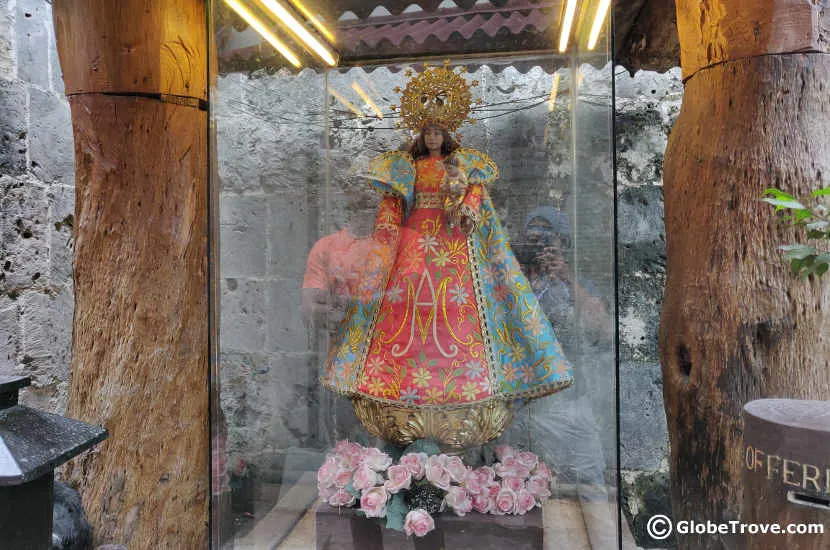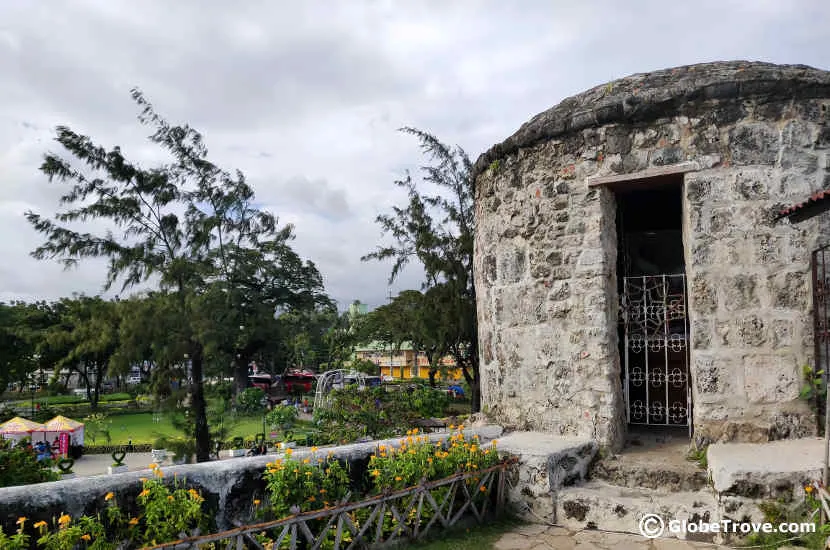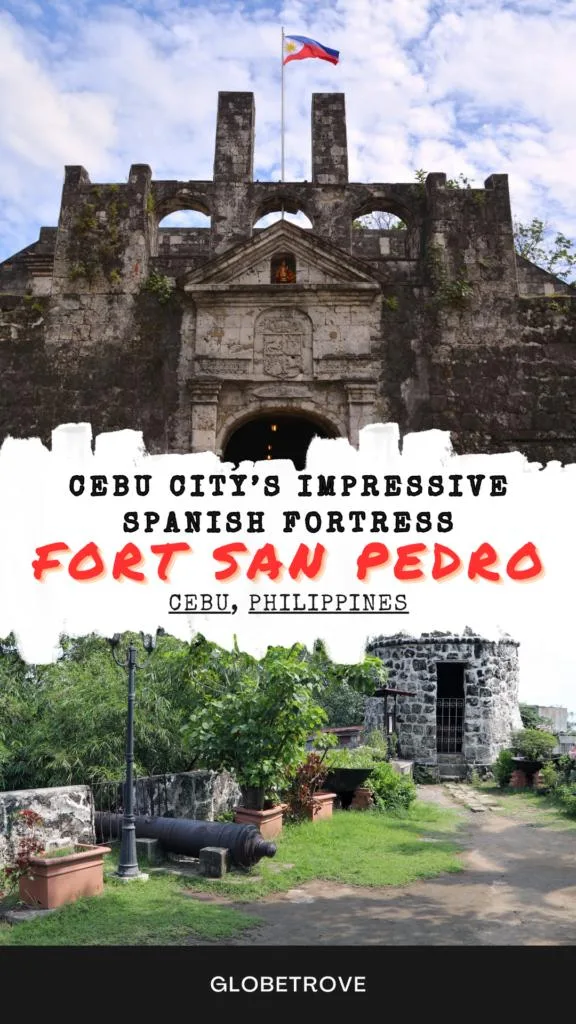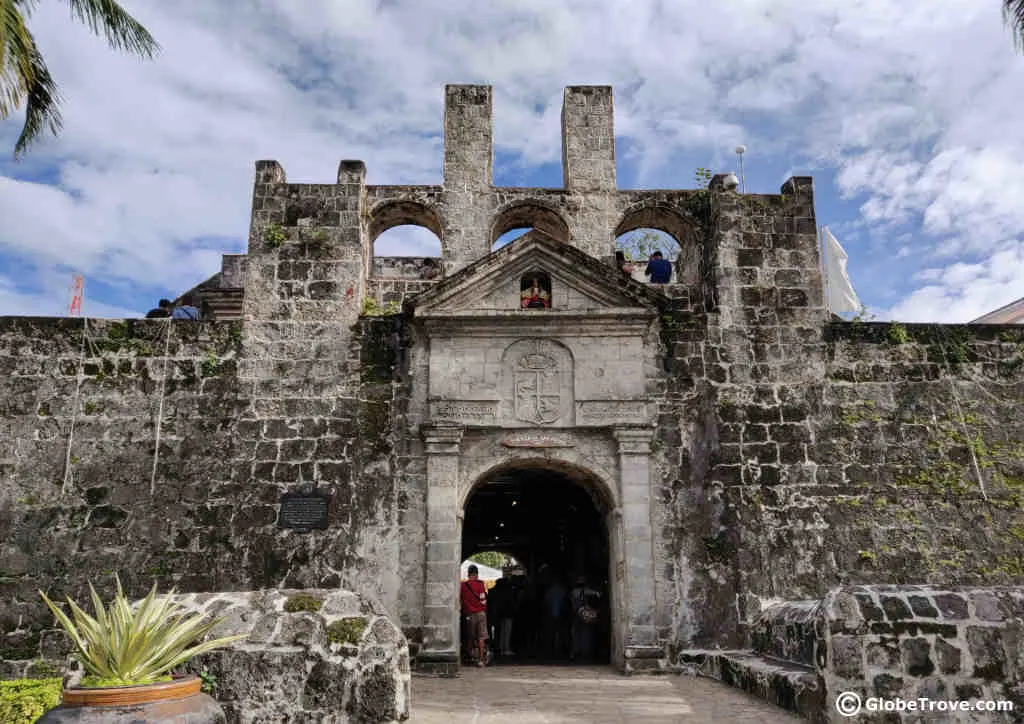Located in the heart of Cebu City, Fort San Pedro is one of the places that you must visit if you have time in the city. Made of brick and mortar it is the first triangular fort that I have ever seen. That isn’t saying much though since most of my experience with forts is in India.
This particular gorgeous gem is one of the remnants of Spanish colonialism in the Philippines. I can’t believe that we almost missed visiting it. Luckily we caught the ferry from Bohol to Cebu early. A big bonus was that Fort San Pedro was open on Sunday.
This post may contain affiliate links. As an Amazon Associate, I earn a small commission from qualifying purchases at no additional cost to you. Read my disclaimer for further information.
🏠 Want to explore all the sights of Cebu? Consider booking the Private Cebu & Lapu-Lapu City Tour. It covers all the highlights of the city 🏠
Table of Contents
Location Of Fort San Pedro
Fort San Pedro Address: A. Pigafetta Street, Cebu City, 6000 Cebu, Philippines
For San Pedro is so iconic that you don’t really need to give people the specific address. Almost any local will direct you in the right direction. The fort remarkable in its appearance and you can spot almost as soon as you come close. It is a popular spot for tourists to visit and for locals to hang out at.
Fort San Pedro History
When the Spanish landed in Cebu, the fort was initially built to provide security to the members of the Spanish expedition. Its construction commenced on the 5th of May 1565 after a man called Miguel Lopez de Legaspi arrived on the island.
As I mentioned before, the fort was triangular and its wooden palisade enclosed a few fresh water wells. You can still find one operational well when you enter. It is speculated that the fort was named San Pedro after Legaspi’s flagship.
Fort San Pedro Entrance Fees
The entrance fees aren’t expensive. Each adult (both local and foreigners) are charged a fare of 30 PHP. Children between the age of 7-20 years pay 20 PHP and senior citizens with a valid I.D. are charged 24 PHP. Parking fees are also applicable.
It is 20 PHP for a car or van and 40 PHP for a bus or coaster. The tickets can be obtained from the counter under the main archway.
Inside Fort San Pedro
I have to say that I was rather surprised by the number of things that were there inside the fort. I thought that we would make a quick trip in and out but we landed up spending a little over half and hour inside. Even if you aren’t interested in the all the historical stuff, you will still find Fort San Pedro rather picturesque.
Our Lady Of The Fort

Our Lady Of The Fort.
Our Lady of the Fort or The Virgin of Remedies is one of the most visited parts of the fort. It is also the first point of interest as you walk into the fort walls. It is said that this is supposed to be the second oldest image of the Virgin Mary in the Philippines.
There is an interesting tale behind this image. It is said that the people of Cebu found this image in a well in the fort somewhere between the years of 1570 to 1575. The Cebuanos took it as a miracle especially since many cures took place from the water of the well where she was drawn.
There however is another tale that coincides with this folklore. It is said that the Queen of Cebu along with many other women was baptized by the Spaniards and presented with the statue of Mother Mary.
Since they were not instructed about Christianity, they returned to their normal ways after the Spaniards left and buried the idol. 44 years later Legaspi arrived with his expedition. It probably how the natives landed up drawing the image from the well.
I can’t be sure if it is the same well that is active but once you catch a glimpse of the replica of the statue (the original was sadly lost in World War II), you can head to the last fresh water well in the fort. Intriguingly enough, it is now a wishing well and people toss in coins as they say their wishes. We couldn’t resist but toss in one too!
The Museum
Fort San Pedro also has a museum inside. This museum isn’t very large but it houses a couple of gorgeous paintings, models of the ships that the Spaniards used to come to Cebu and the original flag that was taken from one of the crew members during the battle of Manila Bay on 13th August 1898.
Information About Fort San Pedro
After you are done with the museum, stop a bit and read about the history of Cebu and the history of the Fort. There are two large boards up that talks about how Cebu passed through different hands.
From the Spaniards to the Japanese to the Americans, it will open your eyes and give you a different perspective when you walk through the city later.
Pistaym
The Pistaym is a collection of vintage City photographs that are on display just before you reach the upper level of the fort. It makes an interesting walk through to see how Cebu transformed.
The photographs are in black and white as can be expected and they are rather well displayed with short snippets of information beneath each photograph.
The Upper Level Of The Fort

At the top of Fort San Pedro.
The upper level of Fort San Pedro if beautiful and if you have a nice clear day, you can click a lot of gorgeous photographs. I loved looking at the aged wall. Shawn pointed out that the stones that we walked on were limestone.
In fact, if you look closely enough, you can identify the coral that formed the stone. So while you are walking through history, you are also technically walking on fossils!
Three Bastions at the three corners of the fort have particular symbolic value here. Each one is dedicated to a different person. They are called La Concepcion (South West), Ignacio de Loyola (South East) and San Miguel (North East).
Each of the Bastions are labelled with plaques explaining why they are dedicated to the person. They make interesting reads.
Completing our round of the upper level brought an end to our exploring. I have to say that Fort San Pedro was one of my favourite spots in the city and I would recommend not missing it if you are in the area.
Fort San Pedro FAQ
What Is Fort San Pedro Famous For?
Fort San Pedro is the oldest triangular shaped fortification in the country. It is small but unique. The fort is particularly famous because it served as the center of the first Spanish settlement in the country. Later during the revolution (19th century), it was taken by the Filippinos. The fort served as a stronghold for their revolutionary activities.
Why Should We Visit Fort San Pedro?
Aside from the fact that the fort is a historical monument, there are a lot of reasons why you should visit. There are loads of historical artifacts that are on display which are pretty interesting. The fort itself is very pretty and the views from the top of the fort are spectacular.
🏠 Want to explore all the sights of Cebu? Consider booking the Private Cebu & Lapu-Lapu City Tour. It covers all the highlights of the city 🏠
Have you been to Fort San Pedro in Cebu City? What did you love most about the gorgeous fort? We would love to hear all about it in the comments below.

*This post contains Affiliate links

